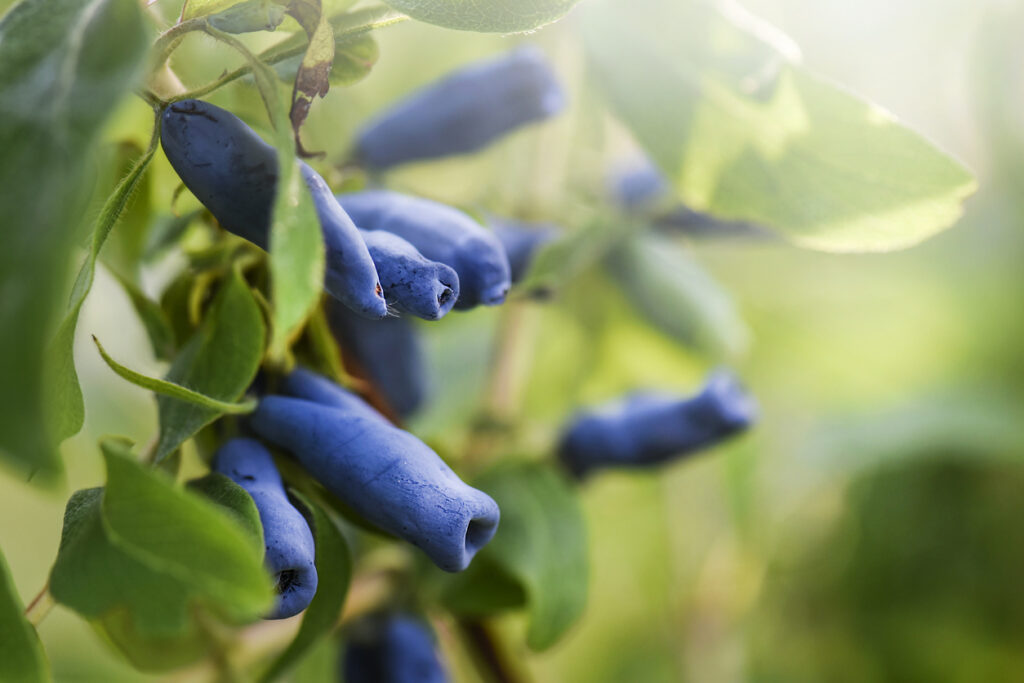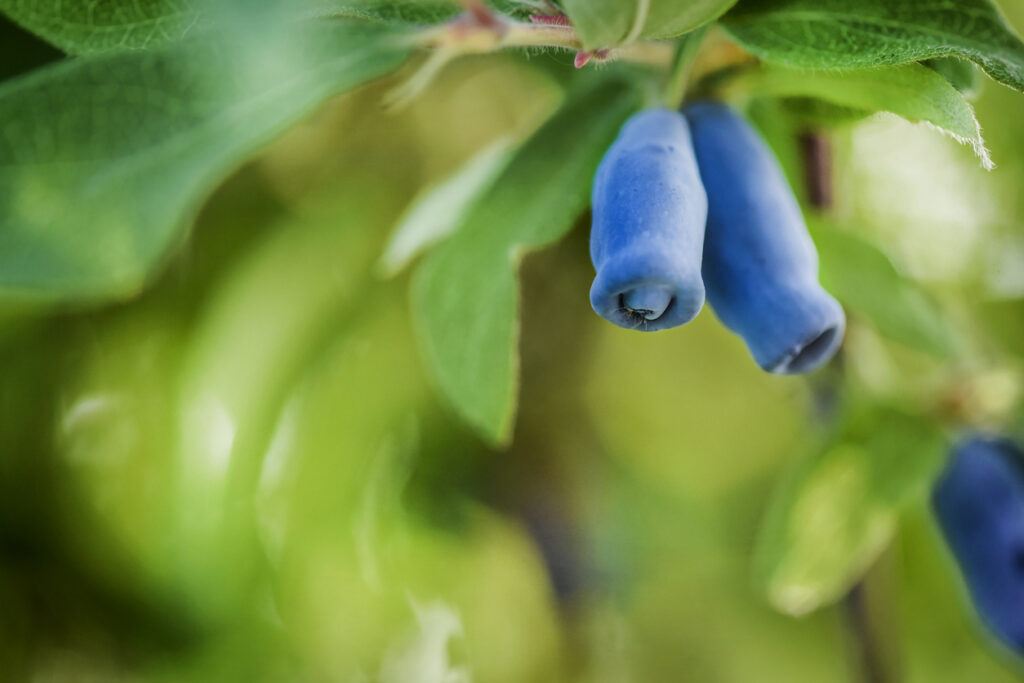Honeyberry Care - How To Grow And Harvest Haskap Berry
If you're into garden landscaping, why non have an edible landscape? Honeyberry, or haskap berry, is the right reply to your culinary and blueprint schemes. Notorious for having a taste that defies descriptions, the honeyberry is a hardy shrub that grows well in the northern parts of the United States. Its popularity is growing steadily especially with the introduction of different cultivars and varieties from all over the world.

A healthy fruit, the honeyberry is packed with more antioxidants than blueberries. You can use information technology in frozen yogurt or desserts to supersede blueberries. And different blueberries, they don't crave special soil to grow. And then if y'all're looking for a new addition to your garden this twelvemonth, why not give the honeyberry a endeavor? Read on to observe out more about this mysterious shrub and how to grow and care for it in your garden.
Honeyberry at a Glance
A lot has been written nearly the sense of taste of honeyberry (Lonicera caerulea). But nobody managed to pinpoint the exact taste of this mystery berry. Suffice information technology to say that information technology'southward a wild combination of blackberry, kiwi, ruby, and grape all rolled into one. To complicate things farther, each different variety and cultivar also has its own unique flavor and taste. So rather than endeavor to describe the zesty sense of taste, allow's turn our attention to the shrub itself.
As a member of the honeysuckle family unit, honeyberry shrubs abound to about 8 feet tall. Some cultivars will merely reach three feet making them ideal for indoor planting. It goes by many other names around the globe where it's known every bit haskap in Japan while the Russians simply call it zhimolost.
A hardy shrub that can tolerate very depression temperatures, the honeyberry has a USDA hardiness zone of 2. Even in the frigid temperatures of Montana, honeyberries thrive and blossom unbothered by the harsh weather conditions. The shrubs can withstand temperatures every bit low as -55 F. while the blossoms will bloom and pollinate in weather as cold as xx degrees F.
The average shrub has a lifespan of fifty years and will first producing berries in the first year of its life. The berries are dark blue and have thin skin. When you breach the skin, the fleshy berries tend to cook in your mouth.
Honeyberry Varieties
With a hardy shrub that produces mystery berries that put your tongue in a tizzy like the honeyberry, you tin expect to have plenty of cultivars to cull from. And one time once again the haskap berry doesn't disappoint. Whether y'all prefer the Japanese varieties or the Russian flavors, or the American cultivars, there'due south plenty to go around and satisfy every taste.
- Happy Giant: This variety comes from Russia with beloved. The berries are larger than average and have a tarty gustatory modality in the oral fissure. The shrub reaches 6 feet alpine and 5 feet wide with dumbo foliage and fast growth rates. One time the tree matures in its fifth twelvemonth, y'all can expect to get 12 pounds of berries every yr.
- Giant'south Heart: This giant is Japanese in origins. The oval-shaped berry reaches about one inch in length and has a sweet flavor. The mature shrub grows to 5 feet tall and the same in width. It has hardiness zones between 2 to 9 and produces nigh 10 pounds of berries from the quaternary yr onwards.
- Blue Deport: A member of the Blue Treasure Family unit, this Japanese cultivar has juicy berries that melt in the mouth. Similar all other honeyberry varieties, information technology needs to be pollinated by a different cultivar. It as well reaches five feet tall at maturity and starts producing berries in the first year.
- Blueish Storm: A member of the Happy Dream family, this shrub grows to half-dozen feet alpine and flowers in April. It tolerates different types of soil and has hardiness zones between two to 7 in the E declension and v to 9 in the Due west coast. The best times to institute it are in the fall well before the first frost.
- Blue Q: A Russian cultivar that belongs to the Blue Q family. It but reaches 5 anxiety alpine which is short past Russian standards. It grows upright with dense foliage and a dome-like canopy. The berries are usually smaller than an inch in size and you lot can expect a decent ingather of between half dozen to 8 pounds from the fourth year of the tree's life onwards.

How to Abound Honeyberry
Since nosotros're talking well-nigh a shrub whose lifespan averages 50 years, fast growth is non one of the honeyberry's top qualities. Of course, you can grow it from seeds, but y'all'll need to have a lot of patience to get it to germinate. Moreover, shrubs grown from seeds unremarkably take upward to three years to acquit fruit, unlike honeyberries started from a cutting. So it'south all-time to become a sapling from a nursery to relieve yourself a lot of time. Here we embrace starting the honeyberry from a cut in easy steps.
- Choose a mature tree that's at to the lowest degree 5 years sometime and choice a salubrious branch to cutting.
- Utilize a clean blade or pruning shears to cutting about half-dozen inches of the branch. Make sure the branch doesn't have cuts.
- Place the cutting in a jar full of h2o and keep it in a sunny spot.
- Change the water every few days since the cut could rot in stagnating h2o.
- After about 4 weeks the outset roots will shoot out of the cutting submerged in the water.
- Fill a minor container with a regular potting mix and water it to brand it moist.
- Dig a hole in the soil about three inches deep and establish the cut in the hole.
- Fill up the hole with soil and pack it to push out air pockets.
- Don't allow the soil go dry out. Proceed information technology moist regularly for the adjacent couple of months.
- Take the institute outside for a few hours every mean solar day to harden information technology.
- When leaves prove at the top of the sapling, y'all know that the root system is well established and you're gear up to movement it to its permanent place outdoors.
- Pick a spot in the garden that gets either full sunday or partial sun.
- Dig a hole deep plenty to accommodate the rootball of the sapling.
- Ease the sapling out of the container with a dodder of soil around the root system.
- Identify the sapling in the pigsty so that the old soil marking on the stem lines with the peak of the hole.
- Fill the hole with soil and pack it to go along the sapling standing upright on its own.
- H2o the sapling to help the soil settle.
Honeyberry Care
While it takes fourth dimension and patience to get the honeyberry started, this hardy shrub is easy to care for. It hardly requires pruning in the start few years and tin tolerate just about whatsoever soil and atmospheric condition conditions. It'due south an platonic shrub to grow in your garden even if you have harsh weather condition conditions in the winter.
Soil
You lot don't accept to fix the soil before planting the honeyberry. It tin grow in moist also as dry out soil. Either rich or poor soil is expert enough to start this hardy tree. However, for the best interests of a high yielding ingather, you lot want to make sure the soil is well-tuckered. You're not just planting a tree to test its endurance. You'd expect to eat some delicious berries from the shrub past the end of the first year. So the less stress the tree goes through, soil-wise, the ameliorate. Also, brand sure the pH levels are hovering around 6.0 or 6.5.
Mulching
It's not often that we talk about mulching as an essential part of a tree's care. But in the case of the honeyberry, the right mulching results in good crop yields and tastier berries. Past right mulching, we mean using rotting leaves of shredded oak bawl that decomposes in the soil and releases its precious nutrients slowly. A thick layer of mulch in the late fall helps the immature shrub withstand the sharp drop in temperature and keeps the shallow roots from freezing. By the next spring, you can remove the mulching to protect the roots confronting overheating and reduce the likelihood of having waterlogged soil.
Fertilization
If you decided to go ahead and establish your honeyberry in poor soil or ane that y'all didn't bother to bank check, so fertilization becomes vital for the shrub'due south care. Most likely the tree volition let you know that information technology'south non getting enough nutrients from the soil. The leaves will look discolored and the foliage lacks its usual density and vigor. During the outset 4 to 5 years of the tree'southward life, you need to fertilize it iii times a year. The first in the early spring with a nitrogen-rich fertilizer. The 2nd application in May with a balanced fertilizer. Finally, finish the twelvemonth off with ane final application in October. For organic fertilization, y'all can use aged manure once every couple of years.
Watering
Frequent watering is of import for the survival of the young honeyberry. Since its roots float near the surface of the soil, it volition get nigh of its h2o from irrigation or rainfall. Keep the soil moist as best you tin, providing the tree with nearly one to two inches of water every week. In the fall, you lot'll need to cutting back on irrigation until the next leap.
Pollination
Fifty-fifty though bumblebees will shoulder the burden of pollinating your honeyberries, you still demand to have betwixt three to five different cultivars growing in shut proximity. That's because both the male and female flowers develop at different times and each variety needs to be pollinated past pollen from a different cultivar.
Harvesting Honeyberry
If waiting for the cutting to develop roots tested your patience, you lot won't take to await for long to sense of taste the showtime berries from your very ain honeyberry shrub. Past the finish of the first year, y'all'll take ripe berries beckoning you to option them and eat them fresh off the tree.
To exam the berries for ripeness, requite them a tug, if they come off the tree easily, then information technology's time to harvest them. Option all your berries at once and store them in the freezer. They tend to perish quickly in the fridge.
Source: https://www.diys.com/honeyberry/
Post a Comment for "Honeyberry Care - How To Grow And Harvest Haskap Berry"